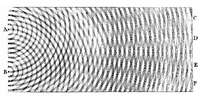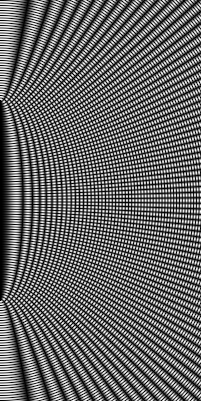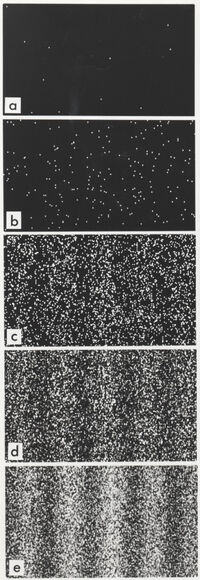Assessment |
Biopsychology |
Comparative |
Cognitive |
Developmental |
Language |
Individual differences |
Personality |
Philosophy |
Social |
Methods |
Statistics |
Clinical |
Educational |
Industrial |
Professional items |
World psychology |
Philosophy Index: Aesthetics · Epistemology · Ethics · Logic · Metaphysics · Consciousness · Philosophy of Language · Philosophy of Mind · Philosophy of Science · Social and Political philosophy · Philosophies · Philosophers · List of lists

Double-slit diffraction and interference pattern
The double-slit experiment consists of letting light diffract through two slits, which produces fringes or wave-like interference patterns on a screen. These interference patterns will result in projected light and dark regions that correspond to where the light waves have constructively (added) and destructively (subtracted) interfered.
The experiment can also be performed with a beam of electrons or atoms, showing similar interference patterns; this is taken as evidence of the "wave-particle duality" predicted by quantum physics. Note, however, that a double-slit experiment can also be performed with water waves in a ripple tank; the explanation of the observed wave phenomena does not require quantum mechanics in any way. The phenomenon is quantum mechanical only when quantum particles—such as atoms, electrons, or photons—manifest as waves.
Importance to physics[]

Thomas Young's sketch of two-slit diffraction of light.
Although the double-slit experiment is now often referred to in the context of quantum mechanics, it was originally performed by the English scientist Thomas Young c.1801 in an attempt to resolve the question of whether light was composed of particles (the "corpuscular" theory), or rather consisted of waves traveling through some ether, just as sound waves travel in air.
The interference patterns observed in the experiment seemed to discredit the corpuscular theory, and the wave theory of light remained well accepted until the early 20th century, when evidence began to accumulate which seemed instead to confirm the particle theory of light.
The double-slit experiment, and its variations, then became a classic Gedankenexperiment (thought experiment) for its clarity in expressing the central puzzles of quantum mechanics; although in this form the experiment was not actually performed with anything other than light until 1961, when Claus Jönsson of the University of Tübingen performed it with electrons[1][2], and not until 1974 in the form of "one electron at a time", in a laboratory at the University of Milan, by researchers led by Pier Giorgio Merli, of LAMEL-CNR Bologna.
The results of the 1974 experiment were published and even made into a short film, but did not receive wide attention. The experiment was repeated in 1989 by Tonomura et al at Hitachi in Japan. Their equipment was better, reflecting 15 years of advances in electronics and a dedicated development effort by the Hitachi team. Their methodology was more precise and elegant, and their results agreed with the results of Merli's team. Although Tonomura asserted that the Italian experiment had not detected electrons one at a time—a key to demonstrating the wave-particle paradox—single electron detection is clearly visible in the photos and film taken by Merli and his group.
In September 2002, the double-slit experiment of Claus Jönsson was voted "the most beautiful experiment" by readers of Physics World.
Results observed[]
The bright bands observed on the screen happen when the light has interfered constructively—where a crest of a wave meets a crest. The dark regions show destructive interference—a crest meets a trough. Constructive interference occurs when
- where
- is the wavelength of the light,
- d is the separation of the slits,
- n is the order of maxima observed (central maximum is n=0),
- x is the distance between the bands of light and the central maximum (also called fringe distance), and
- L is the distance from the slits to the screen.
This is only an approximation and depends on certain conditions.
It is possible to work out the wavelength of light using this equation and the above apparatus. If d and L are known and x is observed, then λ can be easily calculated.
A detailed treatment of the mathematics of double-slit interference in the context of quantum mechanics is given in the article on Englert-Greenberger duality.
Shape of interference fringes[]

The wavefronts resulting from two pinholes.
The theoretical shapes of the interference fringes observed in Young's double slit experiment are straight lines which is easily proved.
In case two pinholes are used instead of slits, as in the original Young's experiment, hyperbolic fringes are observed. This is because the difference in paths travelled by the light from the two sources is a constant for a fringe which is the property of a hyperbola.
If the two sources are placed on a line perpendicular to the screen, the shape of the interference fringes is circular as the individual paths travelled by light from the two sources are always equal for a given fringe. This can be done in simpler way by placing a mirror parallel to a screen at a distance and a source of light just above the mirror. (Note the extra phase difference of π due to reflection at the interface of a denser medium)
Quantum version of experiment[]
By the 1920s, various other experiments (such as the photoelectric effect) had demonstrated that light interacts with matter only in discrete, "quantum"-sized packets called photons.
If sunlight is replaced with a light source that is capable of producing just one photon at a time, and the screen is sensitive enough to detect a single photon, Young's experiment can, in theory, be performed one photon at a time—with identical results.
If either slit is covered, the individual photons hitting the screen, over time, create a pattern with a single peak. But if both slits are left open, the pattern of photons hitting the screen, over time, again becomes a series of light and dark fringes. This result seems to both confirm and contradict the wave theory. On the one hand, the interference pattern confirms that light still behaves much like a wave, even though we send it one particle at a time. On the other hand, each time a photon with a certain energy is emitted, the screen detects a photon with the same energy. Under the Copenhagen Interpretation of quantum theory, an individual photon is seen as passing through both slits at once, and interfering with itself, producing the interference pattern.
A remarkable result follows from a variation of the double-slit experiment, in which detectors are placed in each of the two slits, in an attempt to determine which slit the photon passes through on its way to the screen. Placing a detector even in just one of the slits will result in the disappearance of the interference pattern. The detection of a photon involves a physical interaction between the photon and the detector of the sort that physically changes the detector. (If nothing changed in the detector, it would not detect anything.) If two photons of the same frequency were emitted at the same time they would be coherent. If they went through two unobstructed slits then they would remain coherent and arriving at the screen at the same time but laterally displaced from each other they would exhibit interference. However, if one or both of them were to encounter a detector, then they would fall out of step with each other, that is, they would decohere. They would then arrive at the screen at slightly different times and could not interfere because the first to arrive would have already interacted with the screen before the second got there. If only one photon is involved, it must be detected at one or the other detector, and its continued path goes forward only from the slit where it was detected.
The Copenhagen interpretation posits the existence of probability waves which describe the likelihood of finding the particle at a given location. Until the particle is detected at any location along this probability wave, it effectively exists at every point. Thus, when the particle could be passing through either of the two slits, it will actually pass through both, and so an interference pattern results. But if the particle is detected at one of the two slits, then it can no longer be passing through both—its presence must become manifested at one or the other, and so no interference pattern appears.
This is similar to the path integral formulation of quantum mechanics provided by Richard Feynman (although Feynman stresses that this is merely a mathematical description, not an attempt to describe some "real" process that we cannot see), in which a particle such as a photon takes every possible path through space-time to get from point A to point B. In the double-slit experiment, point A might be the emitter, and point B the screen upon which the interference pattern appears, and a particle takes every possible path—through both slits at once—to get from A to B. When a detector is placed at one of the slits, the situation changes, and we now have a different point B. Point B is now at the detector, and a new path procedes from the detector to the screen. In this eventuality there is only empty space between (B =) A' and the new terminus B', no double slit in the way, and so an interference pattern no longer appears.
When observed emission by emission[]

Electron buildup over time
Regardless of whether it is an electron, a proton, or something else on that scale, where it will arrive at the screen is highly determinate (in that quantum mechanics predicts accurately the probability that it will arrive at any point on the screen) but in what sequence members of a series of singly emitted things (e.g., electrons) will arrive is completely unpredictable. The experimental facts are so highly reproducible that there is virtually no argument about them, but the appearance of there being an uncaused event (because of the unpredictability of the sequencing) has aroused a great deal of cognitive dissonance and attempts to account for the sequencing by reference to supposed "additional variables".
For example, when electrons are fired at the target screen in bursts, it is easy to account for the interference pattern that results by assuming that electrons that travel in pairs are interfering with each other because they arrive at the screen at the same time, but when laboratory apparatus was developed that could reliably fire single electrons at the screen the emergence of an interference pattern indicated that each electron was interfering with itself and therefore in some sense the electron had to be going through both slits. For something that most people continue to imagine to be an unimaginably small particle to be able to interfere with itself would suggest that this "sub-atomic particle" was in two places at once, but that idea is strongly at odds with the truism, "You cannot be two places at once." It was easier to conceptualize the electron as a wave, and that evasion of awareness of the dual or complementary wave-particle duality may have made the experiment more palatable for those who otherwise would have been deeply disturbed by it.
When the double-slit experiment is performed one electron at a time with sensitive apparatus the same interference pattern emerges that would be seen if multiple electrons were fired simultaneously as had always been done with the cruder previously available apparatus. So the appearance of an orderly and consistent universe was maintained, albeit one in which everything with atomic dimensions had to be conceived as having some sort of wave nature.
However, when one electron (proton, photon, or whatever) is fired at a time, it also becomes possible to detect the point on the screen at which it arrives—and another result was demonstrated that could not easily be squared with experience of the macro world, the world of everyday experience. In everyday experience we are accustomed to a seemingly analogous result. If one tests a firearm by locking it in a gun mount and firing several rounds at a target, a scatter pattern of bullet holes will appear in the target. We know from long experience that a badly made gun firing badly made ammunition will scatter shots fairly widely. We can learn and understand how flight path deviations are caused, and progress in firearms and ammunition production leads to tighter and tighter patterns of bullet holes. But that is not what happens in the new double-slit experiment.
Speaking in terms of electrons again, when they are fired one at a time through a double-slit apparatus they do not cluster around a single point diametrically opposite the emitter but instead one by one fill in the same old interference pattern with which we have now become quite familiar. However, they do not arrive at the screen in any predictable order. In other words, knowing where the last electron appeared on the screen tells us nothing about where the next electron will hit.
The electrons (and the same applies to photons and to anything of atomic dimensions used) arrive at the screen in an unpredictable and arguably causeless random sequence, and the appearance of a causeless selection event in a highly orderly and predictable formulation of the by now familiar interference pattern has caused many people to try to find additional determinants in the system which, were they to become known, would account for why each impact with the target appears.[3]
When scientist observed which slit the electrons where passing through, the electrons behaved like bits of matter instead of a wave of potentials, they created two lines of hits with no interference pattern as if they were simply small marbles.
See also[]
- Photon dynamics in the double-slit experiment
- Elitzur-Vaidman bomb-testing problem
- Quantum eraser experiment
- Quantum coherence
- Photon polarization
References[]
Further reading[]
- Tipler, Paul (2004). Physics for Scientists and Engineers: Electricity, Magnetism, Light, and Elementary Modern Physics, 5th ed., W. H. Freeman. ISBN 0-7167-0810-8.
- Gribbin, John (1999). Q is for Quantum: Particle Physics from A to Z, Weidenfeld & Nicolson. ISBN 0-7538-0685-1.
- Feynman, Richard P. (1988). QED: The Strange Theory of Light and Matter, Princeton University Press. ISBN 0-691-02417-0.
- Sears, Francis Weston (1949). Optics, Addison Wesley.
External links[]
- Simple Derivation of Interference Conditions
- The Double Slit Experiment
- Double-Slit in Time
- Keith Mayes explains the Double Slit Experiment in plain English
- Carnegie Mellon department of physics, photo images of Newton's rings
- Java demonstration of double slit experiment
- Double-slit experiment animation
- Double-slit experiment cartoon animation
- Electron Interference movies from the Merli Experiment (Bologna-Italy, 1974)
- Freeview video 'Electron Waves Unveil the Microcosmos' A Royal Institution Discourse by Akira Tonomura provided by the Vega Science Trust
- Movie showing single electron events build up to form an interference pattern in the double-slit experiments. (File size = 3.8 Mb)(Movie Length = 1m 8s)
| This page uses Creative Commons Licensed content from Wikipedia (view authors). |

